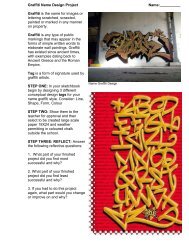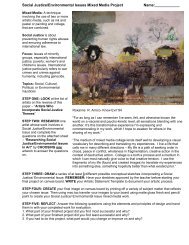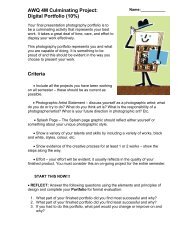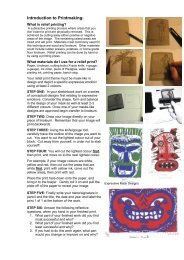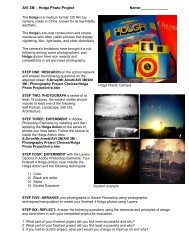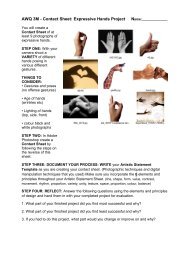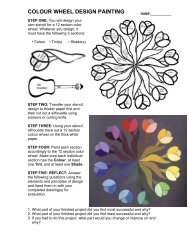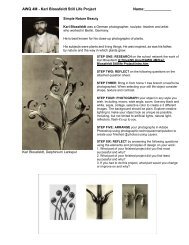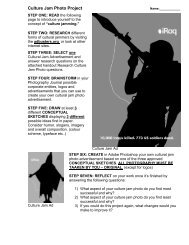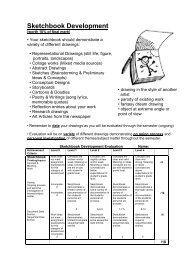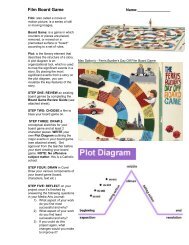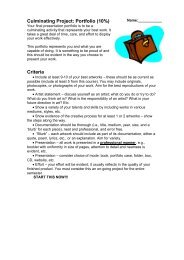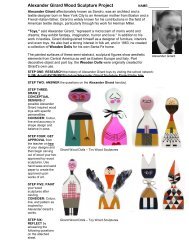Fashion Design Drawing (.PDF)
Fashion Design Drawing (.PDF)
Fashion Design Drawing (.PDF)
Create successful ePaper yourself
Turn your PDF publications into a flip-book with our unique Google optimized e-Paper software.
<strong>Fashion</strong> <strong>Design</strong> <strong>Drawing</strong><br />
Name:____________<br />
You have been hired by a design company to create a drawing of a series (3) original fashion designs based on a particular<br />
art movement/time period.<br />
STEP ONE: Choose one movement/time period<br />
to choose from:<br />
• Renaissance<br />
• The Baroque & Rococo<br />
• The Neoclassical<br />
• Romanticism<br />
• Canadian<br />
• First Nations<br />
• Japan<br />
• China<br />
• India<br />
STEP TWO: RESEARCH the different kinds of<br />
fashion designs associated with your chosen<br />
movement/time period. Answer the attached<br />
question sheet: <strong>Fashion</strong> <strong>Design</strong> <strong>Drawing</strong>:<br />
Research Questions.<br />
STEP THREE: DRAW: In your sketchbook draw<br />
3 different conceptual sketches of different<br />
fashion design outfits<br />
– Your finished drawing will show 3 different<br />
designs related to a chosen<br />
season/collection/movement time period. (as<br />
shown right) Print off source material to work<br />
from.<br />
• Consider the elements and principles of<br />
design (Line, Form, Shape, Unity)<br />
• Your designs must be unified somehow as<br />
being from the same collection/ movement/time<br />
period.<br />
• Your work must show clear evidence of a<br />
researched source(s) for your chosen time<br />
period/ movement.<br />
Have your sketches approved by the teacher<br />
before starting your large drawing. WRITE your<br />
Artistic Statement Template to document your<br />
artistic process.<br />
STEP FOUR: REFLECT: Answer the following<br />
questions using the elements and principles of<br />
design:<br />
1. What part of your finished project did you find most successful and why?<br />
2. What part of your finished project did you find least successful and why?<br />
3. If you had to do this project, what part would you change or improve on and why?<br />
Rococo: A collection of fashion inspired by the Rococo era. Fall<br />
2007 Couture-Christian Dior<br />
Renaissance <strong>Fashion</strong>: Court of Charles<br />
VIII.-Clothing - Expedition into Italy<br />
Renaissance <strong>Fashion</strong>: Court of Catherine de'<br />
Medici-Ladies Clothing Student <strong>Design</strong>
Rococo: A collection of fashion inspired by the Rococo era. Fall 2007 Couture-Christian Dior
K/U: <strong>Fashion</strong> <strong>Design</strong> <strong>Drawing</strong>: Research Questions<br />
Name:___________<br />
1. What movement/time period have you chosen to research?<br />
2. What kind of fashion design are you focusing on researching?<br />
3. Who designed your first researched fashion design piece and why?<br />
4. What is the form and function of your first researched fashion design piece?<br />
Form:<br />
Function: • Seasonal: Winter, Spring, Summer, Fall<br />
5. What material(s) techniques, and processes were used to create it?<br />
6. What is the historical, social, political, economic in which the researched fashion design<br />
was created?<br />
7. How does the form and function of your first researched fashion design reflect your chosen<br />
movement/time period?<br />
8. What kind of mood/feeling do you get from your first researched fashion design and why?
9. Who designed your first researched fashion design piece and why?<br />
10. What is the form and function of your first researched fashion design piece?<br />
Form:<br />
Function: • Seasonal: Winter, Spring, Summer, Fall<br />
11. What material(s) techniques, and processes were used to create it?<br />
12. What is the historical, social, political, economic in which the researched fashion design<br />
was created?<br />
13. How does the form and function of your second researched fashion design reflect your<br />
chosen movement/time period?<br />
14. What kind of mood/feeling do you get from your second researched fashion design and<br />
why?
Artistic Statement Template<br />
Name:____________<br />
<strong>Fashion</strong> <strong>Design</strong> Title:______________________________________________<br />
A) Influence(s) and research from past and present fashion design works:<br />
B) <strong>Drawing</strong> techniques used in my work and how they support my intended fashion<br />
design message:
<strong>Fashion</strong> <strong>Design</strong> <strong>Drawing</strong> Rubric<br />
Name:_________<br />
Knowledge/<br />
Understanding<br />
Demonstrates<br />
understanding of the<br />
elements & principles<br />
of design in the<br />
drawing (e.g. line,<br />
shape, form, unity)<br />
Level 0 Level 1 Level 2 Level 3 Level 4<br />
Work does not<br />
meet<br />
assignments<br />
expectations for<br />
this category.<br />
Incomplete.<br />
0<br />
Student<br />
demonstrates<br />
limited<br />
understanding of<br />
the elements &<br />
principles of design<br />
in the drawing.<br />
0.25<br />
Student demonstrates<br />
some understanding<br />
of the elements &<br />
principles of design in<br />
the drawing.<br />
0.50<br />
Student demonstrates<br />
considerable<br />
understanding of the<br />
elements & principles<br />
of design in the<br />
drawing.<br />
0.75<br />
Student<br />
demonstrates<br />
a high degree of<br />
understanding of<br />
the elements &<br />
principles of design<br />
in the drawing.<br />
1<br />
/1<br />
Thinking/<br />
Inquiry<br />
Specific Time<br />
Period/Movement:<br />
<strong>Fashion</strong> <strong>Design</strong>s<br />
Work does not<br />
meet<br />
assignments<br />
expectations for<br />
this category.<br />
Incomplete.<br />
0<br />
Student depicts<br />
fashion designs in<br />
the drawing that<br />
reflects the chosen<br />
period/movement<br />
with limited<br />
effectiveness.<br />
0.25<br />
Student depicts<br />
fashion designs in the<br />
drawing that reflects<br />
the chosen<br />
period/movement<br />
effectiveness.<br />
0.50<br />
Student depicts<br />
fashion designs in the<br />
drawing that reflects<br />
the chosen<br />
period/movement with<br />
considerable<br />
effectiveness.<br />
0.75<br />
Student depicts<br />
fashion designs in<br />
the drawing that<br />
reflects the chosen<br />
period/movement<br />
with a high degree<br />
of effectiveness.<br />
1<br />
/1<br />
Communication<br />
Clarity:<br />
Discusses research &<br />
influences in the<br />
research questions &<br />
artistic statement<br />
Work does not<br />
meet<br />
assignments<br />
expectations for<br />
this category.<br />
Incomplete.<br />
0<br />
Student discusses<br />
influences in the<br />
research questions<br />
& artistic statement<br />
with limited clarity.<br />
0.25<br />
Student discusses<br />
influences in the<br />
research questions &<br />
artistic statement with<br />
some clarity.<br />
0.50<br />
Student discusses<br />
influences in the<br />
research questions &<br />
artistic statement with<br />
considerable clarity.<br />
0.75<br />
Student discusses<br />
influences in the<br />
research questions<br />
& artistic statement<br />
with a high degree<br />
of clarity.<br />
1<br />
/1<br />
Explains use of<br />
drawing techniques in<br />
the artistic statement<br />
Reflective Questions:<br />
Strength, Weakness<br />
& Next Step<br />
Incomplete.<br />
0<br />
Incomplete.<br />
0<br />
Student explains<br />
use of drawing<br />
techniques in the<br />
artistic statement<br />
with limited clarity.<br />
0.25<br />
Poor, yes/no<br />
answers/limited<br />
incomplete.<br />
0.25<br />
Student explains use<br />
of drawing techniques<br />
in the artistic<br />
statement with some<br />
clarity.<br />
0.50<br />
Somewhat coherent<br />
and somewhat<br />
complete.<br />
0.50<br />
Student explains use<br />
of drawing techniques<br />
in the artistic<br />
statement with<br />
considerable clarity.<br />
0.75<br />
Clear and substantial<br />
answers.<br />
0.75<br />
Student explains<br />
use of drawing<br />
techniques in the<br />
artistic statement<br />
with a high degree<br />
of clarity.<br />
1<br />
Superior and<br />
insightful answers.<br />
1<br />
/1<br />
/1<br />
Application<br />
Creative Process:<br />
Ability to solve a<br />
series of artistic<br />
problems, showing an<br />
awareness of formal<br />
qualities, visual<br />
conventions, and<br />
relevant ideas and<br />
concepts.<br />
Preliminary Sketches<br />
(3)<br />
Creative Process:<br />
Demonstration of Skill<br />
Development &<br />
following procedures<br />
including Clean Up<br />
Work does not<br />
meet<br />
assignments<br />
expectations for<br />
this category.<br />
Incomplete.<br />
0<br />
Incomplete.<br />
0<br />
Preliminary<br />
sketches are<br />
poor/incomplete.<br />
Concepts are<br />
poor/incomplete.<br />
Planning is<br />
tentative or nonexistent.<br />
(0.5)<br />
0.5<br />
Student<br />
demonstrates<br />
limited<br />
effectiveness in<br />
demonstrating the<br />
creative process<br />
and following<br />
procedures.<br />
5<br />
Preliminary sketches<br />
are somewhat clear<br />
and complete.<br />
Concepts are<br />
somewhat complete.<br />
Planning is somewhat<br />
substantial & shows<br />
some alternative<br />
ideas. (1-2)<br />
1<br />
Student demonstrates<br />
some effectiveness in<br />
demonstrating the<br />
creative process and<br />
following procedures.<br />
5-6<br />
Preliminary sketches<br />
are mostly complete.<br />
Concepts are<br />
complete. Planning is<br />
evident & shows<br />
some divergent<br />
thinking is evident. (2-<br />
3)<br />
1-1.75<br />
Student demonstrates<br />
considerable<br />
effectiveness in<br />
demonstrating the<br />
creative process and<br />
following procedures.<br />
7-8<br />
Preliminary<br />
sketches are<br />
thorough &<br />
complete.<br />
Concepts are fully<br />
developed.<br />
Planning is<br />
exceptional &<br />
shows<br />
considerable<br />
flexibility in<br />
thinking. (3+)<br />
2<br />
Student<br />
demonstrates<br />
superior<br />
effectiveness in<br />
demonstrating the<br />
creative process<br />
and following<br />
procedures.<br />
8- 10<br />
/2<br />
/10<br />
Uses elements &<br />
principles of design<br />
and drawing<br />
techniques to<br />
produce an effective<br />
artwork (e.g. shape,<br />
form, space)<br />
Value<br />
(Shade & Tone)<br />
Incomplete.<br />
0<br />
Incomplete.<br />
0<br />
Student<br />
demonstrates<br />
limited use of the<br />
elements &<br />
principles of design<br />
& drawing<br />
techniques to<br />
produce an art<br />
work of limited<br />
effectiveness.<br />
1<br />
Work<br />
demonstrates no<br />
areas of extreme<br />
black or white. The<br />
composition does<br />
not contain<br />
sufficient value to<br />
reflect 3-<br />
dimensionality.<br />
1<br />
Student demonstrates<br />
some use of the<br />
elements & principles<br />
of design & drawing<br />
techniques to produce<br />
an art work of some<br />
effectiveness.<br />
2-3<br />
Work demonstrates<br />
few areas of extreme<br />
black or white. The<br />
composition is grey<br />
overall or contains<br />
minimal value to<br />
reflect 3-<br />
dimensionality.<br />
2<br />
Student demonstrates<br />
considerable use of<br />
the elements &<br />
principles of design &<br />
drawing techniques to<br />
produce an art work<br />
of considerable<br />
effectiveness.<br />
3-4<br />
Work demonstrates<br />
some areas of<br />
extreme black or<br />
white. The<br />
composition contains<br />
sufficient value to<br />
reflect 3-<br />
dimensionality.<br />
3 - 4<br />
A1. The Creative Process: apply the creative process to create a variety of artworks, individually and/or collaboratively;<br />
Student<br />
demonstrates a<br />
high degree of<br />
using the elements<br />
& principles of<br />
design & drawing<br />
techniques to<br />
produce a highly<br />
effective art work.<br />
5<br />
Work<br />
demonstrates<br />
exact & balanced<br />
amounts of<br />
extreme blacks,<br />
whites & greys.<br />
The composition<br />
contains balanced<br />
value to reflect 3-<br />
dimensionality.<br />
5<br />
/5<br />
/5<br />
/27
A1.1 use various strategies, individually and/or collaboratively, to generate, explore, and elaborate on ideas and to develop and revise<br />
detailed plans for the creation of art works that address a variety of creative challenges (e.g., use brainstorming, concept webs, and/or<br />
groups discussions to formulate original ideas for thematic works and/or works of personal expression; use research and discussions with<br />
a partner to explore and elaborate on ideas; use diagrams, notes, and/or outlines to help them formulate detailed plans for the art work;<br />
revise their plans on the basis of reflection)<br />
A1.2 apply the appropriate stages of the creative process to produce and revise two- and three-dimensional art works using a variety of<br />
traditional and contemporary media (e.g., explore, experiment with, and refine their use of a variety of media; choose a medium/media<br />
appropriate for their planned art work; reflect on the effectiveness of preliminary versions of their work; revise their art work on the basis of<br />
reflection and useful feedback)<br />
A1.3 document their use of each stage of the creative process, as well as varied and extensive research, in a portfolio that includes art<br />
works created for a variety of purposes (e.g., ensure that their portfolio includes evidence of idea generation and elaboration, research,<br />
investigation, planning, exploration, experimentation, and revision; include a variety of works created for different purposes), and review<br />
and reflect on the contents of their portfolio to determine how effectively they have used the creative process<br />
A2. The Elements and Principles of <strong>Design</strong>: apply the elements and principles of design to create art works for the purpose of self-expression and to<br />
communicate ideas, information, and/or messages;<br />
A2.1 explore how elements and principle of design can be used to convey emotion and enhance personal expression, and use a<br />
combination of these elements and principles to create two- and three-dimensional art works that express personal feelings and<br />
communicate specific emotions to an audience (e.g., explore how variations in line, value, form, proportion, and emphasis can be used to<br />
convey various emotions; adapt their findings to enhance expression in their art work)<br />
A3. Production and Presentation: produce art works, using a variety of media/materials and traditional and emerging technologies, tools, and<br />
techniques, and demonstrate an understanding of a variety of ways of presenting their works and the works of others.<br />
A3.2 explore a range of traditional and current materials, technologies, techniques, and tools used by visual artists (e.g., Claude Monet’s<br />
use of optical colour mixing; Andy Warhol’s use of silkscreens; George Segal’s use of plaster bandage; Jean-Paul Riopelle’s use of a<br />
palette knife for impasto application of paint; Daphne Odjig’s use of interconnecting black lines), and adapt and apply them to create<br />
original art works<br />
B1. The Critical Analysis Process: demonstrate an understanding of the critical analysis process by examining, interpreting, evaluating, and reflecting<br />
on various art works;<br />
B1.1 analyse their initial response to art works (e.g., describe their initial reaction to an art work and determine which specific aspects of<br />
the work and their personal experience led to their reaction)<br />
B1.2 deconstruct the visual content and the use of elements and principles of design in their own art work and the work of others (e.g.,<br />
identify individual elements and principles and aspects of the visual content in an art work, interpret their function, and analyse how the<br />
artist has manipulated them to create impact, emphasis, mood, movement, and meaning; compare The Abduction of the Daughters of<br />
Leucippus by Peter Paul Rubens to the cover of a contemporary comic book about an action hero, with reference to the artists’ use of<br />
colour, line, shape, value, balance, and emphasis)<br />
B1.3 explain, with reference to particular works, both historical and contemporary (e.g., J. M. W. Turner’s Rain, Steam, and Speed: The<br />
Great Western Railway; Maya Lin’s Vietnam Veterans Memorial), how knowledge of an art work’s cultural and historical context, achieved<br />
through research, has clarified and enriched their understanding<br />
of the work’s intent and meaning<br />
B1.4 describe and reflect on the qualities of their own art works and the works of others, and evaluate the effectiveness of these works,<br />
using a variety of criteria<br />
B2. Art, Society, and Values: demonstrate an understanding of how art works reflect the societies in which they were created, and how they can<br />
affect both social and personal values;<br />
B2.1 analyse the function and social impact of different kinds of art works in both past and present societies (e.g., the use of art works for<br />
ritualistic and religious purposes; for social and/or political commentary; as propaganda; as symbols of economic or social power; to<br />
commemorate people and/or historical events; to instruct)<br />
B2.2 explain, on the basis of research, ways in which various art works are a response to and a reflection of the societies in which they<br />
were created<br />
B2.3 reflect on and explain how creating and analysing art works has affected their personal identity and values and/or changed their<br />
perceptions of society and social issues (e.g., with reference to their emotional awareness and their ability to express themselves; their<br />
awareness of stereotypes; their understanding of the meaning of objects and symbols associated with a variety of cultural groups; their<br />
awareness of and relationship to their physical environment; their position on social issues such as censorship, discrimination, inequality)<br />
C1. Terminology: demonstrate an understanding of, and use correct terminology when referring to, elements, principles, and other components<br />
related to visual arts;<br />
C1.1 demonstrate an understanding of the elements and principles of design, and use terminology related to these elements and<br />
principles correctly and appropriately when creating or analysing art works (e.g., when describing how they have used elements and<br />
principles in a sculpture to convey a sense of movement)<br />
C1.3 using appropriate terminology, explain the creative process and describe in detail<br />
the critical analysis process, with particular reference to the role of deconstruction in the latter process<br />
C2. Conventions and Techniques: demonstrate an understanding of conventions and techniques used in the creation of visual art works;<br />
C2.1 demonstrate an understanding of a wide variety of techniques that artists use to achieve a range of specific effects (e.g., techniques<br />
used to create the illusion of depth and perspective and to create texture on different surfaces; the use of additive and subtractive<br />
sculpture, layering, positive and negative space, and relief to create effects)<br />
C2.2 demonstrate an understanding of a variety of conventions used in visual arts (e.g., allegory, expressive exaggeration, juxtaposition,<br />
synectics; conventions associated with heroic, narrative, naturalistic, propaganda, realistic, and satirical art),<br />
and explain how they are used in different types of art works<br />
C3. Responsible Practices: demonstrate an understanding of responsible practices in visual Arts.



